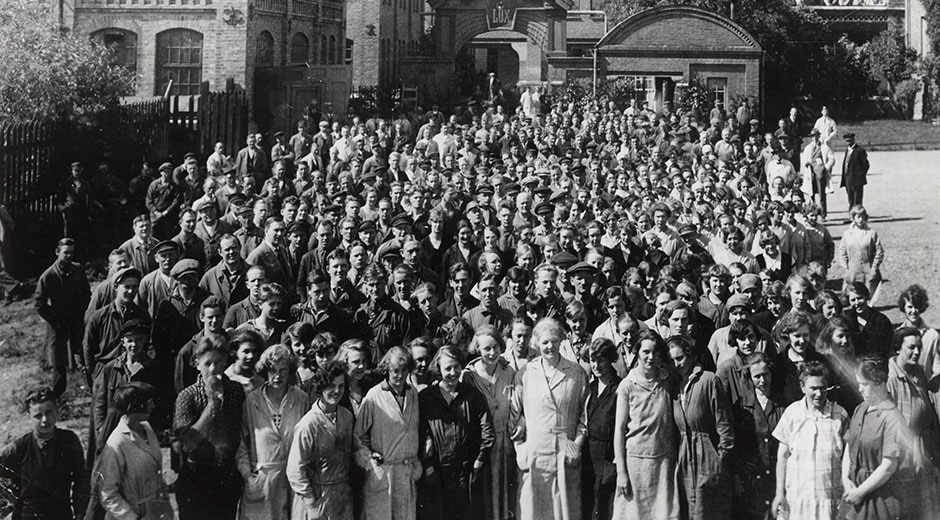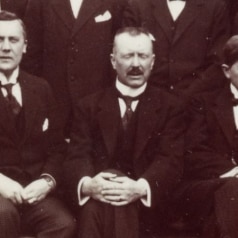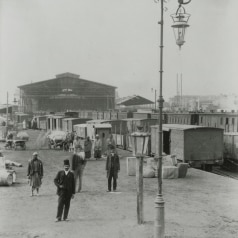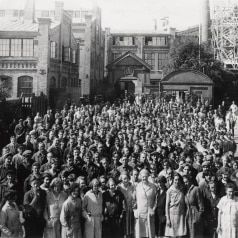Today, exactly 120 years ago, AB Lux was started – the company that would become an important contribution to the formation of Electrolux eighteen years later.
A group of innovators and businessmen, who believed in the new gas lamp, experienced both success and adversity in Lux, but also indirectly contributed to the start-up of the pharmaceutical company Astra Zeneca.
Stockholm, early 1901: A new type of lamp
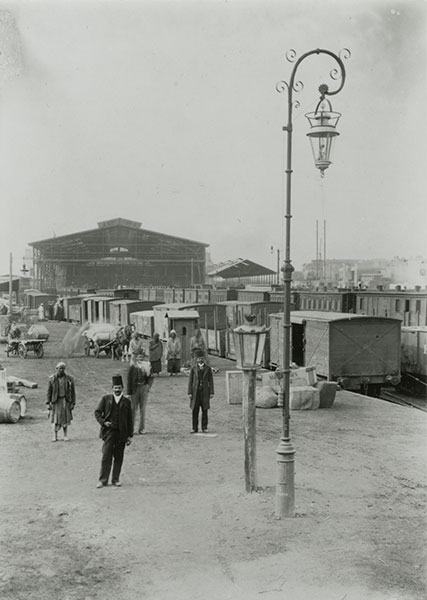 The designer, industrialist and financier Sven Carlsson (1847-1924), who among other things had worked for the Nobel brothers in Russia, sees great opportunities in a completely new type of kerosene lamp designed by the chemist David Kempe. It has a so-called glowing-net that produces an extraordinarily strong glow. Carlsson buys the rights to the construction and starts AB Lux with some partners on February 19 to manufacture and sell the new Lux-lamp. A member of the Wallenberg family, Viktor Wallenberg, is one of the board members, as are P Qvarnström and W Montelius, also chairman of Telefon AB LM Ericsson.
The designer, industrialist and financier Sven Carlsson (1847-1924), who among other things had worked for the Nobel brothers in Russia, sees great opportunities in a completely new type of kerosene lamp designed by the chemist David Kempe. It has a so-called glowing-net that produces an extraordinarily strong glow. Carlsson buys the rights to the construction and starts AB Lux with some partners on February 19 to manufacture and sell the new Lux-lamp. A member of the Wallenberg family, Viktor Wallenberg, is one of the board members, as are P Qvarnström and W Montelius, also chairman of Telefon AB LM Ericsson.
At this time, intensive work is underway in several parts of the world to find the best way to illuminate cities, factories, offices and homes. Electricity is just one of several possibilities, but requires large investments in lines, power plants etc. The competitive advantage of the kerosene- driven Lux-lamp is a strong light that can be used for lighting indoors, in street lamps and in lighthouses. Sven Carlsson makes sure to quickly patent the Lux-lamp technology.
Lux gets off to a flying start. In the first year, agreements are signed with dealers in Germany and Lux continues its expansion on the rest of the continent, in Australia, North America South America and Russia. In 1902, the company provides Sandhammaren lighthouse in Skåne, Sweden with lamps. Gradually, more than 100 Swedish lighthouses are equipped with the Lux system. In 1905, the company supplies outdoor lighting for the Suez Canal.
1907: New factory at Lilla Essingen, Stockholm
The demand for Lux-lamps is so great that in 1907 the company buys a plot on the island of Lilla Essingen outside Stockholm. One year later, production is moved from the cramped premises on Kungsholmen to the newly-built factory on Lilla Essingen. Business is moving fast.
But now the problems also begin. Other companies spot the lucrative lighting market, the new factory costs a lot of money, the expansion of electricity is starting to become a concrete threat and on top of it all, a major strike arrives in Sweden in 1909. The following year Sven Carlsson and the rest of the board pull the brakes and begin to look for other products that can give the foreign sales branches a broader product portfolio. The lamp is not as competitive anymore.
One of these products is an electric vacuum cleaner weighing 20 kilos that looks like a barrel and can be manufactured and sold under license from American Santos. Why not? But the start is slow and in 1912 the annual report states that “vacuum cleaners… have not yet received any significant spread.”
1912: Wenner-Gren enters
It is now the “sales genius” Axel Wenner-Gren (1881-1961) comes into the picture. The 31-year-old Swede has realized the potential of the vacuum cleaner and has gained experience in selling a competing model in Germany with good success but has had a conflict with his German partner. So he contacts the head of Lux, C G Lindblom and promises without blinking that he can sell 500 of their vacuum cleaners a year if he gets the exclusive rights in Germany and France. Lindblom, while concerned he’s an imposter, has nothing to lose.
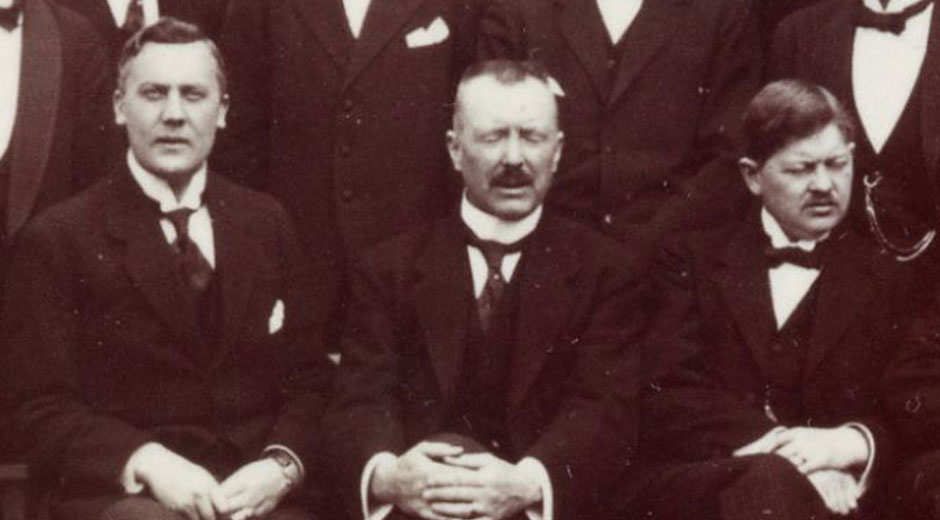
Wenner-Gren knows very well that customers think that the vacuum cleaner is too heavy, so he has already contacted one of the subcontractors to Lux, AB Elektromekaniska, led by the innovative chief engineer Sven Carlstedt. His team quickly succeed in improving the suction capacity, reducing the weight and also making the production cheaper. At the end of 1912, the first really consumer-adapted vacuum cleaner, Lux I, weighing 14 kilos launches. This model continues to be improved at a fast pace to 9 kilos (Lux II) and Wenner-Gren works on making further improvements and even lighter models.
Now Wenner-Gren says he wants 5,000 units a year, and Lux has trouble delivering. But the Lux management realize they have found a lifeline, especially through the sales company in Germany, which has “obtained a particularly good market for the recently started production of electric vacuum cleaners”, as it is called in the annual report.
1916: AGA acquires Lux
Lux continues to manufacture kerosene lamps in parallel, but sales of other lamp models are poor and they are now forced to write down the company’s assets. At the outbreak of war in August 1914 most things stop.
Lux has also met strong opposition in the lighthouse market. In 1904, AB Gasaccumulator (better known as AGA) is founded, which focuses on lighthouse lamps based on acetylene gas. AGA grows rapidly and in 1916 it buys the problem-ridden competitor Lux. However, Lux remains a relatively independent subsidiary of AGA, and collaborates with the owner on lighthouse technology. And vacuum cleaner production remains a separate business within Lux.
1919: Start of sales company Electrolux
When Axel Wenner-Gren sets up AB Electrolux in August 1919, the idea is that Electrolux will be a pure sales company with Lux as the sole supplier of the vacuum cleaners. Wenner-Gren undertakes to buy large volumes of vacuum cleaners from Lux for a ten-year period and Lux undertakes to manufacture only for Electrolux. Wenner-Gren also becomes a partner in Lux.
The production and sale of vacuum cleaners is now gaining momentum and as early as 1923, Lux manufactures over 100,000 vacuum cleaners per year for Electrolux, which sells them in Europe, North America, Latin America and in Australia and New Zealand.
1923: Electrolux takes over Lux
After a dispute in 1923 with one of AGA’s main owners, Handelsbanken, and its chairman, former Prime Minister Arvid Lindman, Wenner-Gren finally buys out Lux from AGA and thus finally gains full control over production at Lilla Essingen. And now an incomparable expansion starts all over the world during the 1920s and 30s, which lays the foundation for today’s global Electrolux.
So what is the connection to Astra – known today as Astra Zeneca? Well, the demand for glowing-nets used in the Lux-lamp forms the basis for another of Sven Carlsson’s companies, AB Keros. In 1908, Keros expands its operations and adds the adjacent product bandages. Other pharmaceutical products are added and in 1913 these are transferred to the newly formed Astra with Sven Carlsson as the main financier. The rest of the products are transferred in 1916 to AGA, which has just bought Lux.
The rest is history, as they say, both for Lux/Electrolux, AGA and Astra Zeneca.
Keen to know more? Then check out our history book ‘Shape living for the better: The first 100 years of Electrolux,’ which portrays the life of Wenner-Gren and the story of Electrolux that for a whole century has provided millions of homes around the world with new innovations and smart design that shaped living for the better for consumers.


